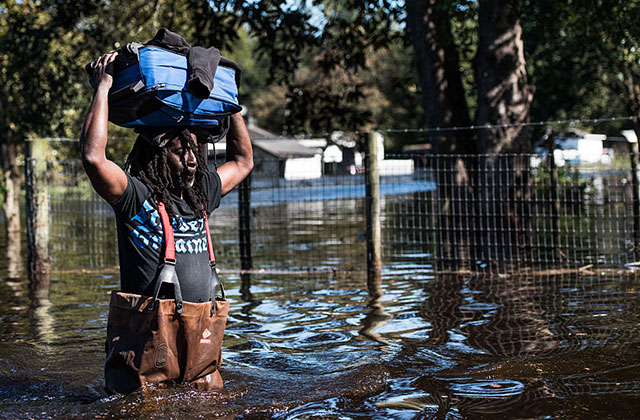North Carolina is still reeling from the aftermath of Hurricane Matthew, the Category 4 storm that killed at least 1,000 people in Haiti and approximately 38 in the United States.
The rain has stopped, yet rivers continue to swell, threatening to flood more communities. The Washington Post reports that “at least one river [is] expected to crest this weekend at nearly double the flood stage.” North Carolina Gov. Pat McCrory is urging residents to evacuate if they live in threatened areas, such as below the Wood Lake Dam and near Kinston. “We’ve had too many deaths,” said McCrory, according to the Post. “Get out. Once the water flows, it’s too late.”
Nearly 4,000 North Carolina residents remain in shelters, reports Reuters, and 7,000 homes were destroyed. Nineteen people in the state lost their lives because of the hurricane. Some of North Carolina’s poorest communities—often with majority Black populations—were hit hardest:
In some hard-hit communities, like Lumberton, the flooding also cut along socioeconomic lines: A white area of town was preserved, while a lower-lying African American section now stands in several feet of water. But in other parts of the state, emergency officials say, a diverse group of people have been pushed from their homes.
“When a flood like this hits, the pain of it is exacerbated by the poverty,” said the Rev. William Barber, president of the North Carolina NAACP. “What we’re talking about, particularly in eastern Carolina, are some of the poorest communities in the country — [B]lack and [W]hite, who already had economic challenges before something like this.”
More flooding is expected this weekend. However, the eastern portion of the state should be spared.
Some good news for eastern NC…the next 7 days will be dry. pic.twitter.com/O0nX8DhLsb
— NWS Raleigh (@NWSRaleigh) October 12, 2016
This situation looks familiar to state officials. In 1999, reports the Post, Hurricane Floyd killed 35 in North Carolina, “most of them from inland drowning in the days after rain subsided.”
In many of these storms, recovery efforts and getting people back into their homes present the largest obstacles. Some of the areas that got hit with water in North Carolina aren’t typically prone to inundation, so many of the homeowners lacked flood insurance. That’s a problem for both owners and state officials. Director of Insurance for the Consumer Federation of American Robert Hunter spoke to the Guardian about this:
“Our model shows about $7.5bn in insured losses. Florida is probably all right, it has mostly wind damage that will be covered by private insurers, although there are a lot of small companies and it remains to be seen if any have too much risk.
But when you get to the flooding in North Carolina it’s a different story. Not a lot of people buy flood insurance and those who do are almost all backed up by Fema, so have the full faith and credit of the United States behind them. For a lot of people it’s either out-of-pocket or disaster relief. It’s unfortunate but that’s the way it is.”
The National Weather Service is providing updates on the continuing damage brought by Hurricane Matthew on its Raleigh, North Carolina Twitter account.
(H/t The Weather Channel, The Washington Post, The Guardian)
